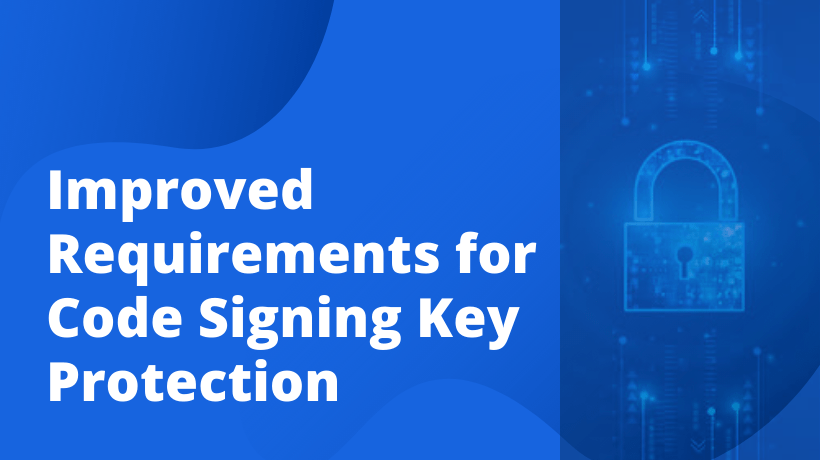
Code signing is broadly recognized as a critical step in conveying trust to software users and protecting companies from harm caused by cybercriminals in the software supply chains or other types of cybersecurity attacks. Code signing certificate indicates that a software author or publisher is who they say they are and that the code has not been tampered with.
Lately, there have been a few high-profile episodes where Cyber criminals have taken private keys that real associations use to sign their applications. These taken keys are then used to sign malware to cause it to create the impression that the malignant code has been marked and dispersed by the casualty associations, giving a misguided feeling of authenticity to the marked noxious code.
These high-profile occasions share a typical subject: programming/Software-based security of private keys utilized for marking application code is a gamble for the environment, given the overall facilitate that cyber-criminal can take and manhandle such keys contrasted with other, stronger, types of security.
Perceiving the gamble that software-based key protection represents, the Code Signing Working Group of the CA/Browser Forum late passed a voting form to reinforce the necessities encompassing private keys utilized for code signing.
Throughout the span of a year, the members of the Code Signing Working Group worked through the Ballot CSC-13: Update to Subscriber Key Protection Requirements to definitively increase present expectations for security while cautiously gauging the weight that new prerequisites might present.
For a long time, the necessities for private keys utilized with EV code signing certificates have been more grounded than OV code signing certificates. While keys utilized with EV code signing certificates should be safeguarded in Hardware Security Modules (HSMs) or signing services, (for example Secure Software Manager, which utilizes HSMs to secure user keys), the assurance necessities for keys utilized for OV code signing certificates are looser.
For instance, software-based key protection arrangements are permitted. While such protection arrangements might be advantageous and easy to execute for users, it is a lot more straightforward for cyber-criminals to compromise the system storing the key and to deceitfully sign vindictive code under the certificate subject’s name.
To alleviate this gamble, effective Nov. 15, 2022, key protection prerequisites for OV code signing certificates are orchestrated to be equivalent to EV code signing certificates.
It’s critical to take note that the new necessities for OV code signing certificates becoming real on Nov. 15 will apply to renewals and reissues of code signing certificates. All in all, a key that is at present stored in a software-based protection solution can’t be utilized in any new certificates issued on or after Nov. 15. The certificate requestor will have to generate a new key under the superior necessities and utilize that key for their new code signing certificate.
Holders of OV code signing certificates can keep on utilizing their current certificates after Nov. 15 regardless of whether the private key meets the new prerequisites. In any case, as referenced over, the new key should be produced that meets the new prerequisites for any future certificates that they demand.
Watch out for impending interchanges in regard to our arrangement to carry out these progressions and any moves you might have to make to the plan.
During CSC-13 discussions, the Working Group members appreciated the security benefits of software-signing services, while also recognizing that some areas of the Code Signing Baseline Requirements need improvement. Conversations are in progress in the working group to additional support these necessities and push ecosystem security forward. These conversations are yet primer, however, we will keep you advised about any happenings as they create.
Integration and automation of code signing workflows within a Continuous Integration/Continuous Delivery (CI/CD) process using our Secure Software Manager improves software security and enforces policy compliance.
Manual code signing cycles can in any case leave software and applications powerless against assault. The National Institute of Technology (NIST) has recognized the penetration of code signing processes as one of the methods utilized by cybercriminals. Key theft shared or misused keys, unapproved access, or server breaks can permit code with malware to be marked and appropriated as trusted software.
Automation of code signing work processes decreases the assault surface in the software development lifecycle (SDLC), disposing of points of weakness by unifying administration and work processes and improving end-to-end security from user access to software release. Integration with DevOps processes guarantees that this superior security act is accomplished without slowing down release cycles.
Our Secure Software Manager further develops software security with code signing workflow automation that lessens points of weakness and delivers end-to-end company-wide security and control in the code signing process.
Manual TLS Management Is Dying – And 47-Day Cert Validity Will Be the Final Nail in the Coffin